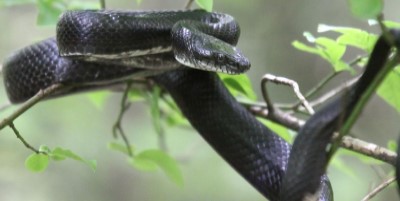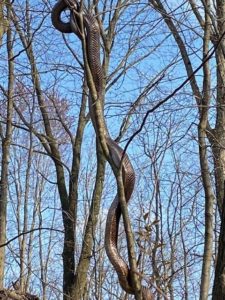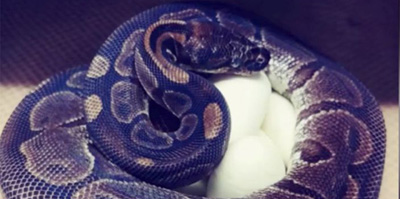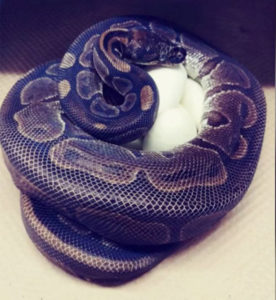





slider1
slider7
slider3
slider6
slider4
slider5

The Canadian province of Manitoba has a remarkably distinct springtime attraction too: tens of thousands of amorous snakes writhing around in pits.
While Manitoba’s tourist agency doesn’t promote the Narcisse Snake Dens with the same zeal as it does Canada’s national human rights museum in Winnipeg, the annual mating ritual of red sided garter snakes nevertheless manages to draw thousands of people, snake fanciers and snakephobes alike, to an otherwise overlooked part of the province for a few days each spring.

The area around Narcisse is so attractive to snakes for the same reasons many farmers abandoned it decades ago: Its thin topsoil sits on top of limestone that water has gradually eroded underground, creating a network of small caves that can be entered through sinkholes.
In a place notoriously cold even for Canada, this is the perfect winter home for snakes.
 The eruption of the snakes each spring, and the 10 days they spend cavorting in celebration, is weather dependent, and hard to predict. Clouds, cool temperatures and rain can all keep them underground.
The eruption of the snakes each spring, and the 10 days they spend cavorting in celebration, is weather dependent, and hard to predict. Clouds, cool temperatures and rain can all keep them underground.
Many years, they slither out in time to make snake viewing a popular Mother’s Day outing. This chilly spring, they emerged toward the end of May.
“It is likely the biggest concentration of snakes in the world” said Prof. Robert T. Mason, a professor of integrative biology at Oregon State University, who has come to Narcisse every spring since 1982.
“It’s amazing to me how many people want to see these snakes.” he said. “They are perfect ambassadors for the reptile world.”
The snakes are harmless to people. While they can bite, the effect is more like a head butt than a tearing of flesh.

In Pittsburg someone spotted a giant snake on a trail at a place called Frick Park (that’s a funny name) which triggered a bit of concern from some of the locals. Although quite large, it turned out there was little cause for alarm. Reptile specialists at the Pittsburgh Zoo and PPG Aquarium identified the snake as a Black Rat Snake. (Luckily someone took a picture of the snake climbing a tree)
Experts have assured the public that the species is “harmless.” Wendell Hissrich, a Pittsburgh public safety director said “We were initially concerned it may have been a boa constrictor or a python, And like alligators may have been transported to this area, become too large for a resident, and they let it go in the park.” Officials also stated “While not commonly seen in the park, this harmless species of snake is native to the area and very beneficial to the environment,” they added. “We thank the public for their interest and for helping us identify this park visitor.”
Pittsburgh Public Safety Director Hissrich noted “We will probably remove the snake and put it into a safer habitat,” . “Somewhere within the city or the county that the public doesn’t have to be worried about it and the snake can live its life.”
 The lesson here is this: If you see a snake, and you can’t identify it or you aren’t qualified to handle snakes, just leave it alone. Obviously you should give it space, and just go about your business and let the snake go about his. If, however, the snake in question is really really big, you should alert the officials for two reasons.
The lesson here is this: If you see a snake, and you can’t identify it or you aren’t qualified to handle snakes, just leave it alone. Obviously you should give it space, and just go about your business and let the snake go about his. If, however, the snake in question is really really big, you should alert the officials for two reasons.
1. there is always a possibility the snake could be dangerous to small animals or even people, and
2. It could be someones pet that decided to go for a walk and got lost and just wants to go back home.
And this particular snake might have just been out enjoying the fresh air and sunshine, minding his own business, and not hurting anyone. It is a PUBLIC park afterall.
Snakes are an essential part of our environment. They help keep our ecosystem in balance by doing a very important job. And they work their asses off doing that job. (that’s kinda funny since a snake doesn’t really have an ass)
So when it comes to snakes, be grateful for their help in making our world a better place and just leave em the hell alone! Unless it’s a Rattlesnake or Cobra or a Black Mamba. If it’s one of those you should probably run.

This little gem from the news might explain why Ball Pythons are so resilient
The St. Louis Zoo announced earlier this week that one of their ball pythons recently laid eggs — even though she hadn’t “been with a male in over 15 years!”
“On July 23, something incredible happened,” the Missouri zoo wrote on Facebook, noting that another facet that makes the news so thrilling is that the snake in question is “over 50 years old,” making her the “oldest snake documented in a zoo.”

Ball pythons usually begin laying eggs between the ages of 4-6, and stop before their sixties, according to the St. Louis Post-Dispatch.
The zoo went on to offer two explanations for how this possibly could have happened.
“Ball pythons?, native to central and western Africa, are known to reproduce sexually and asexually, which is called facultative parthenogenesis,” they wrote, noting that “snakes are also known to store sperm for delayed fertilization.”
For now, the eggs remain a mystery, but the zoo’s staff is working to get to the bottom of it!
“As the keepers continue to incubate the eggs, they will be sending off samples for genetic testing,” the post concluded.
As for how the eggs are doing, three remain incubated while two were used for genetic sampling and another two did not survive, according to the St. Louis Post-Dispatch.
Mark Wanner, a zoological manager of herpetology at the zoo, went on to tell the outlet that if the remaining snakes survive, they’ll hatch in around a month. “That would be pretty incredible,” Wanner remarked.
The St. Louis Post-Dispatch also reported that the female snake has laid eggs on two other occasions, once in 1990 and again in 2009